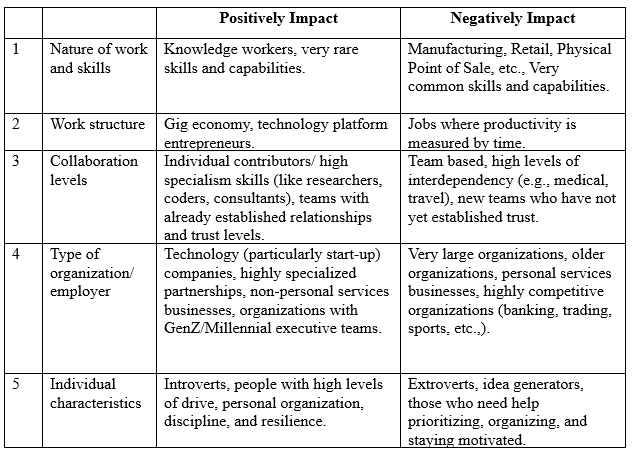Dr Helmut Schuster and Dr David Oxley, above are co-authors of A Career Carol: A Tale of Professional Nightmares and How to Navigate Them, published by Austin Macauley Publishers, available on Amazon
In some respects, hybrid and remote work have been with us for ever. What has changed is the scale, context and, most importantly, the dynamics.
The Evolving Context
Over the past 20 years, remote work has been steadily increasing. Between 2006 and 2015, the number of people who worked at least partially ‘from home’ grew from 19%-24%. The main drivers here were greater virtual connectivity and a gradual acceptance that occasional remote working wasn’t detrimental.
The Remote Working Black Swan
In 2020, companies rushed to implement remote working, as a defensive, humanitarian initiative. By the summer of 2020 nearly 50% of the workforce was working remotely. Much has been written about how COVID ‘accelerated’ remote working.
We take more of a realist view on the explosion of hybrid/remote working practices over the past three years. They were introduced in large part as temporary measures, with little calculation to the ultimate business desirability. We believe many management teams probably believed that some compromise to optimum performance was likely, but that health and safety were far more important concerns.
Radically Changed Dynamics
But perhaps all of this is far less important than where we now find ourselves. The simple fact is that however the explosion of flexible work arrangements occurred, they created a very new dynamic. We are no longer arguing about making traditional workplace telecommuting an exception to ‘normal’ office attendance. Instead, we are in dialogue with a remote workforce that needs persuading a return to office is necessary.
We were watching a London news report a few weeks ago where people were asked about returning to the office and some replied, “well, I won’t accept that, it simply doesn’t work for my lifestyle.” We were struck by the insular and dismissive tone of the statement. It reinforced that among a significant number of employees, remote working now teeters between expectation and entitlement.
What has receded from consideration is the more familiar, rational, logical assessment of being prepared to make compromises. People have typically looked at employment options with a view to give and take… pros and cons.
Two Wrongs Don’t Make a Right
Of course, one guaranteed way to make this all worse, is for CEO’s and CHRO’s to take a petulant approach. Issuing demands, dictates and ultimatums. There are huge risks for organizations that attempt to bully employees back to pre-COVID work environments. This disrespects employees’ legitimate perspectives.
Meeting emotion with emotion, irrationality with irrationality, is a recipe for conflict not resolution.
Facts, Objectivity, and Shared Purpose Is the Solution
The answer is to work with facts, data, evidence, and logic. WFH has no uniform application. It is not a tide that floats or grounds all boats. Some jobs need to be done on premises… others really don’t. By way of illustration, we have put a quick table together roughly categorising the types of jobs and people who might find remote working more or less productive:

One must spend the time to understand the objective data and then consider rational WFH applications. It is critical for all organizations to take the time to (a) explain the reasons why returning to an office schedule is desirable, (b) emphasize that flexibility will be retained where it mutually makes sense and (c) give reasonable periods for transition… keeping everyone updated along the way, including making adjustments.
This all becomes much easier if there is a clear overarching spirit of shared purpose. We cannot overstate how powerful this can be in aligning interests on a shared desire for the organization to achieve something greater than any one individual. When this is present, the personal agendas and preferences tend to melt away.
Ways of working are a foundation of culture
Organizations should not be shy in encouraging a return to work in the office… where it makes sense to do so. We tend to preach balance in most things. Rather than suggest it’s all or nothing, black or white, great companies tend to excel at finding symbiotic solutions.
We think it’s a mistake to look at WFH/Hybrid working as one might an annual vacation policy, health benefit, or even pay review. How we work, whether we are physically proximate, indeed, whether we are in an open plan socially collaborative workspace or in cubicles, has a huge effect on an organization’s ability to create kinship, fellowship, and a soul. It helps new employees get a feel for how things really work. It helps leaders set a tone for how work should be done. We get to interact with and learn from people who are not directly in the critical path of our ‘to do’ lists.
Our punchlines here are simple:
1 – Communal workspace can be a competitive advantage: the community, serendipitous collaboration, and creativity of working together cannot be easily replicated remotely. Organizations should not be apologetic about seeking to, sensibly, return to this.
2 – Jobs and Individuals react very differently to remote working: It’s easy to point out the types of jobs that seem silly to suggest being done remotely, but it is easy to forget some individuals find it much harder than others.
3 – Unknown long-term risks: For example, an overlooked risk of long-term remote working is whether the physical and mental conditions may be sub-optimal. We have spent decades working to make offices healthy and productive spaces. It is impossible to say the same about the long-term effects of working from home.
4 – Remote working is here to stay: The bottom-line here is pick your favorite analogy… Genie or toothpaste… we suggest being data and evidence led on making any decisions to reverse existing WFH arrangements.
 Dr Helmut Schuster and Dr David Oxley are co-authors of A Career Carol: A Tale of Professional Nightmares and How to Navigate Them, published by Austin Macauley Publishers, available on Amazon
Dr Helmut Schuster and Dr David Oxley are co-authors of A Career Carol: A Tale of Professional Nightmares and How to Navigate Them, published by Austin Macauley Publishers, available on Amazon


